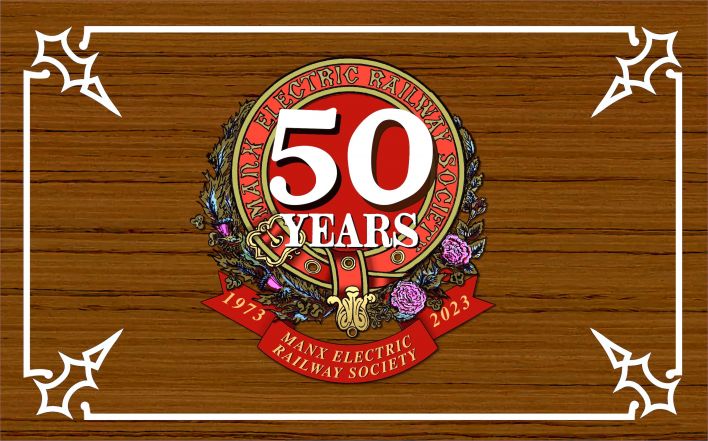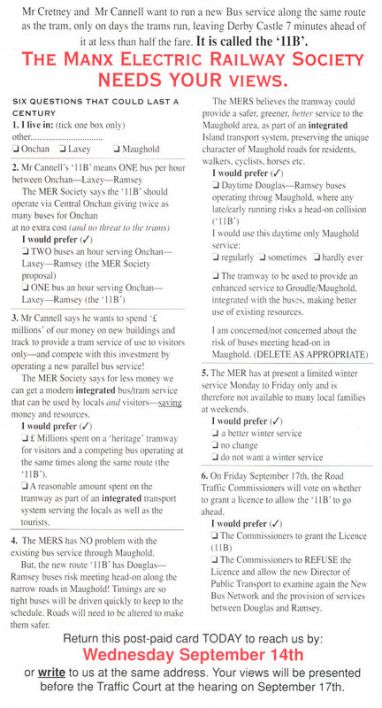AROUND 7.30pm on the night of August 2nd 1973, on a verandah overlooking Douglas Bay, three holidaying boys broke into a little yellow kiosk adjacent to the crazy golf course for a quick smoke. On the railway below, Car 22 rattled past on a routine service to Ramsey. Such an event would have gone unrecorded had a discarded match not accidentally started a fire on the kiosk floor. Having failed to stamp it out, the boys fled. As the plastic booth burned, fire spread to the adjacent acrylic wall of the main building and quickly to the roof. As the compère on stage joked about chip pans, the organist played “The Blue Danube". Soon stunned disbelief, then pandemonium ensued. As the Summerland leisure centre burned, fifty people died and many others were seriously injured. It remains one of the worst peacetime fire disasters of modern times - a blot literally and metaphorically on the Manx landscape. As the 'Oroglas' inferno raged, a few feet away, staff in the Manx Electric Railway sheds, at great danger to themselves, played hoses on the buildings and tram cars, their actions that evening undoubtedly saving the depot and its contents from destruction and the line from closure. This was not the first time the MER faced a serious threat to its survival. It wasn't to be the last…
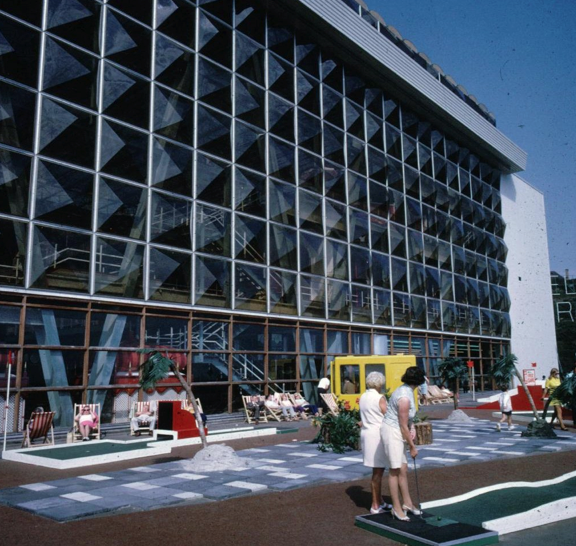 The original ill fated Summerland complex, shortly after it's opening in 1971
The original ill fated Summerland complex, shortly after it's opening in 1971
A few months earlier on the night of Thursday April 5th 1973 “a small number of ladies and gentlemen met in Douglas to consider the practicality of forming a society to co-ordinate the efforts of those concerned with the future of the [Manx Electric] railway. The meeting was unanimous and felt something should be done to save the railway if closure was threatened." Less than a fortnight later on Monday April 16th 1973, a public meeting was held in Laxey chaired by its Mayor. Attendees included Members of the House of Keys, local Commissioners, Railway employees, representatives of the Tourist Industry and others. At the conclusion of the meeting it was resolved to form a society with an annual local subscription of 25p. It was unanimously agreed that it be called “The Manx Electric Railway Society." By August that year the membership had reached 300 and the Society Journal “MANN-TRAM" had reached Issue number 3.
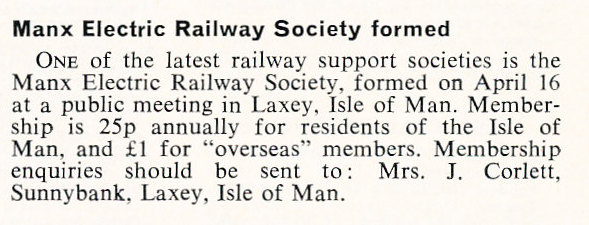 June 1973 Issue of Railway Magazine
June 1973 Issue of Railway Magazine
Top of the list of ways by which the fledgeling society would “seek to actively promote the continued retention, operation and development of the Manx Electric Railway and other Manx tramways at reasonable cost" was the word 'political'. It was this that set the MERS aside from many voluntary railway organisations whose main role is to provide hands on help or fund raising. This fact continues to set the society apart from many other enthusiast groups and 50 years ago, it wasn't long before the new society was able to put its political muscle to the test.
Early meetings of the MER Society were held at Laxey’s Mines Tavern , the licensee at the time was Frank Burdett who was a founding committee member of the Society. The Mines Tavern (formerly the Station Hotel) has featured the famous tram bar since the early 1970s, the paint finish and superb sign-writing were the work of former MER craftsman painter Mr Billy Boyd. (Photo: MERS Collection)
Amongst other things, the bar includes a period advert for the Manx Electric Railway Society, the message is just as valid today as it was in the early 1970s. (Photo: MERS Collection).
In September 1973 the Manx Government's Executive Council commissioned a report by BR subsidiary Transmark “to examine the economic and engineering status of the Manx Electric Railway". At that time the line was subsidised to the extent of over £60,000 per annum, and had received over £500,000 in the 15 or so years since nationalisation. In May 1974, the Chairman of ExCo moved in Tynwald that the winter service on the line should cease and the Laxey Ramsey section abandoned completely. That would have been the end of the matter, had a 'storm of protest' not ensued, not least from the recently formed MERS and an amendment in Keys by the Speaker called for the matter to be referred to what became the Transport Steering Committee (TSC) of Tynwald.
1975 was a bad year for the Island's railways. In March the TSC proposed and got Tynwald approval to overturn the stay of execution, to abandon the winter service and close the Laxey Ramsey line for good. Despite another temporary reprieve, the Laxey Ramsey closure was eventually confirmed on December 9th. The last tram had already departed on September 30th. Elsewhere the Peel and Ramsey lines of the steam railway were being torn up for scrap, with just the 'shortened section' between Castletown and Port Erin left running. Even Ramsey's Queen's Pier Tramway (later operated from August 1975 by the MERS until its closure) was seen as being under threat. That winter, the Isle of Man had no railed transport in operation. It was time that the Island's railway societies showed they had teeth…
.jpeg?m=1462700188) George Hearse and his son were regular drivers on the Queens Pier Tramway when the line was operated by the Manx Electric Railway Society. George, who was founding Chairman of the Society, poses alongside the Planet Engine at the pier entrance during the late 1970s. George sadly passed away in 2013. (Photo courtesy of Eric Corkish)
George Hearse and his son were regular drivers on the Queens Pier Tramway when the line was operated by the Manx Electric Railway Society. George, who was founding Chairman of the Society, poses alongside the Planet Engine at the pier entrance during the late 1970s. George sadly passed away in 2013. (Photo courtesy of Eric Corkish)
Aware of the potential the 1976 General Election, both the revamped committee of the MER Society and the Island's Steam Railway Supporter's Association began a vociferous campaign that contrasted starkly with the cordial 'luncheon' invites of the past. On the Steam Railway side, a 34-page report on the truncated Steam Railway had been published in September 1975, a move resulting in amongst other things a national feature on BBC TV's 'Nationwide'. A decision in Keys in October recommending the reopening of the whole Douglas to Port Erin line was hailed as 'a signal victory for the Steam Railway Supporters'. Meanwhile the MERS 'unleashed' its booklet “Is this Any Way to Run a Railway", described at the time as a “mini-Nuremburg Trial of some Manx Politicians". This too gained significant coverage on ITV and was serialised in the local press. Fearless joint MERS/IOMSRSA representation at almost every Tynwald candidate's election meeting presented the case for the Island's railways in toto. Adverts were placed in local newspapers and questionnaires sent to every candidate.
The effect of all this was spectacular. “Candidates finally totalled 71, and swept away with a tide of anger and resentment was...the Chairman of the last MER Board." Half the sitting members lost their seats. Only one of the five Board members was re-elected.
To assist the new MER Board's fight to reopen the northern line (and to demolish other documents circulating at the time) the MERS commissioned its own “authoritative Technical Report dealing with safety, methods and costs of rehabilitating the Ramsey line in time for the 1977 season." The report had “been prepared by a Civil Engineer and Associate Fellow of the Permanent Way Institution with appropriate knowledge and experience of Light Railway operation". On February 16th 1977, Keys voted 23 to 1 to reopen the northern line, an event which took place on June 25th that year.
The line secure (at least for a “trial of three seasons"), the MER Society's attentions turned to supporting the railway by assisting its new Board. After a smooth start, the Board's 'consultant' later 'chief executive' began to give real reason for concern. Following purchase of the Steam Railway from the old IMR Co by the Government in 1978, combined operation of the MER and IMR set in motion an “orgy" of wanton destruction (especially on the steam line), crazy schemes and wasted opportunity that sparked a 10-year battle between the Island's railway organisations and the MER Board. Despite offering constructive advice, any criticism of even such things as the relatively trivial rebranding of the IMR and MER as “Isle of Man RailwayS" [sic] and the replacement of the corporate crests of both the IMR and MER (described at the time as more 'hilarious' than heraldic), or more serious unnecessary expenditure on the complete replacement of the IMR's Nunnery Bridge, brought responses seen at the time as deliberate provocation; eviction of the Railway Supporters from their Douglas Station shop, the banning of sales of the MERS booklet “Manx Transport Kaleidoscope", and the setting up in direct opposition to the voluntary sales operation by the MER Board itself. As the Society journal noted “the viability of having the Board's highest paid employee in attendance at a street stand is unknown."
By 1980, the success generated by the “Millennium of Tynwald 979-1979 - 1000 Years a 1000 welcomes" had evaporated, with hotel bookings reported to be 60% down. Despite this MER passenger figures were proving remarkably resilient. On the downside, the buses had been subsumed by the MER Board and its 'chief executive'. Observers watched in dismay as events unfolded. Something had to be done. The MERS much delayed booklet “Unofficial Guide to Isle of Man RailwayS" [sic] was an “incredible compendium of Manx Railway cartoons. Billed officially as “so long as both the human civilisation and transport systems survive, there will always be room for a kindly jest in passing", unofficially it could have been seen as the opening salvo of the 1981 General Election. Once again, both the MERS and the IOMSRSA decided to reconvene the alliance that had made such an impact five years earlier, with a 'Joint Railways Action Committee'.
In the run up to the election, and in these pre-internet times, the MERS conducted an opinion poll in which 711 people were surveyed about the record of the MER Board. The less than complimentary results were published for all to see in the Society journal. The JRAC produced a pamphlet 'Fiasco' giving electors some details of the “sad, costly and shocking story of the MER Board of Tynwald" which was widely distributed along with newspaper advertisements carrying the same message. Only two members of the MER Board held on to their seats. Regrettably, the Board's 'chief executive' remained in situ. The overarching point about the importance of and support for the Island's railways had been made however and in 1983 Tynwald agreed to the retention of the Laxey Ramsey line 'indefinitely'.
Following the success of its booklet “Manx Transport Kaleidoscope", the Society Journal “MANN-TRAM" had increasingly begun coverage of other forms of Island transport, with regular news about buses, shipping and the rise of a Steam Packet competitor in the form of ManxLine. Reflecting the changed political structure of the Island's insular transport, and the interests of readers, “MANN-TRAM" 39 became “Manx Transport Review" from issue 40. This allowed the Society and its journal license to cover in more detail subjects beyond the MER. The original title proposed “Manx Transport Quarterly" was amended after it was pointed out that this implied the production of four journals per year. Given the erratic publication dates of “MANN-TRAM", it was thought best to avoid this commitment. Just as well, as ongoing 'delays' in publication of the society journal have continued to the present day. “Manx Transport Review" soon began to have impact, and the Board “in an attempt to produce an improved cosmesis" began issuing its own unintentionally hilarious “Focus on Transport" column in the “Isle of Man Weekly Times".
In the spirit of investigative journalism and in an attempt to shed light on the problems of getting to and from the Island by sea, the MERS and its journal MTR had been carrying out “fourteen months" of a passenger shipping survey. 614 respondents were questioned comparing the views of the troubled IOMSPCo passengers with those of Sealink-ManxLine as it had become. The survey attempted to scientifically quantify what was clear to many though not all, that the modern ro-ro alternative had much to offer compared with the antique service offered by its established rival. The exercise was repeated to include freight operators following the merger of Sealink and the Steam Packet in 1985. Shipping became a major feature of MERS publications with the benign history “Eight Decades of Heysham-Douglas" followed by the downright vicious “Is This Any Way To Run A Shipping Line - The Crisis in Manx Shipping affairs" covering the background of the demise of the independent Steam Packet Co published in January 1987.
Back on the MER, the Board's first 'chief executive' finally retired in July 1987; the period from 1977 was described by the MERS as “The Lost Decade". The arrival of a new transport executive (aged just 32) and the imminent MER Centenary, prompted hopes that the event would be marked by something other than “a special tram - perhaps with some sandwiches". To help, the MERS put together a proposal for a “Year of Railways" which was presented to the Isle of Man Passenger Transport Board at a meeting in January 1990. The comprehensive and detailed “blueprint for the future of the MER" met with a lukewarm response from the Board's representatives. In “an attempt to stir up interest", the proposals were re-printed in MTR 58 Autumn 1990 and circulated to politicians and the press. The response was immediate and positive, being warmly welcomed and applauded. Letters from politicians, local authorities and enthusiasts poured in to the Society. Everyone it seemed was on board. Everyone except those who mattered - IoM Passenger Transport, its new 'transport executive', and Isle of Man Tourism which it turned out had already developed other ideas.
Unknown to the MERS, Isle of Man Tourism had formulated its own strategy to tempt tourists. Their consultants had dismissed the railways as a 'niche' market' with 'little potential'. (The MERS envisaged a more general event, with family-orientated events as well as unique attractions and access aimed at enthusiasts.) A campaign costing £200,000 had been devised which was to promote 'short break' holidays in which the MER Centenary did not feature. Despite this, the MERS continued to lobby on behalf of the MER and this and overwhelming pressure from politicians and others lead to a remarkable turnaround - at least as far as the Railway side of the Department was concerned.
The 1993 “Year of Railways" became a reality - with the Centenary of the MER at its heart. Despite what was seen as minimal support from the Tourism side of the Department, (licking its wounds after it was revealed that its own “Great Escapes" promotion attracted a claimed 11 (eleven!) visitors, a number thought by others to be more adjacent to '8'), even by their own official figures the Year of Railways attracted 25,000 additional visitors to the Island. Described as “The event of the Decade" by “Railway World", and by another correspondent as “better even than Rocket-150", the instigation of this event by the MERS can be ranked along with the Laxey-Ramsey line campaign of 1976 as one of the great achievements of this organisation. Of course as recorded in MTR at the time, its implementation and success also owed everything to the railway's staff who worked tirelessly to make it happen.
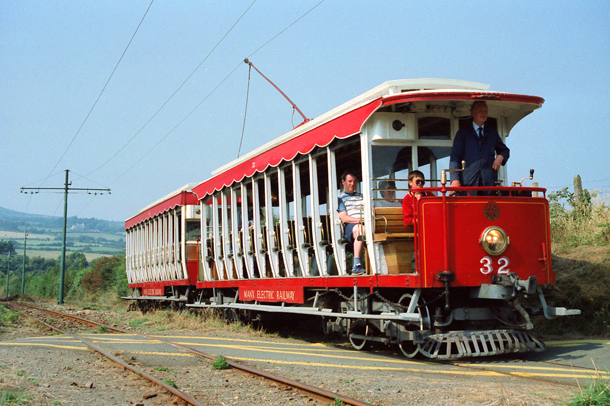 Car 32 and trailer 62 are seen rumbling over Murray's Road crossing on a journey to Ramsey in August 1995. The views from this idyllic spot across Ballaglass Glen and to North Barrule are simply stunning and beyond compare. This is the Manx Electric Railway at its very best. The 1906 built UEC crossbench car looks resplendent, its appearance greatly enhanced by the attention to details such as grey trucks, running boards and white wall tyres - all courtesy of motorman Mike Goodwyn. Mike was the long serving chairman of the MERS, holding office from 1977 till his untimely death in 1999.
Car 32 and trailer 62 are seen rumbling over Murray's Road crossing on a journey to Ramsey in August 1995. The views from this idyllic spot across Ballaglass Glen and to North Barrule are simply stunning and beyond compare. This is the Manx Electric Railway at its very best. The 1906 built UEC crossbench car looks resplendent, its appearance greatly enhanced by the attention to details such as grey trucks, running boards and white wall tyres - all courtesy of motorman Mike Goodwyn. Mike was the long serving chairman of the MERS, holding office from 1977 till his untimely death in 1999.
Calls by the MERS to make 'every year a year of railways' sadly and predictably failed to materialise. The 'transport executive's desire to give everyone a “year off" in 1994 resulted in a watered down “Summer Spectacular" and as the decade rolled on and the number of 'centenaries' diminished, enthusiast provision in the form of special events was reduced year on year. But the prediction made in MTR that it would all end in 'a replacement bus' had yet to happen.
After the success of 1993, the MERS confronted what it perceived as emerging threats to the well-being of the MER. At the beginning of 1996 an envelope plopped through the letterbox of the journal's acting editor. The content was to signal the beginning of an epic debacle the consequences of which could not be foreseen. The envelope contained a damning analysis of the Department's 'New Bus Network'. Subsequent events surrounding this and the MERS, which were to take on epic proportions, took a very heavy toll on the individuals involved.
At about the same time a proposal emerged in to replace the Derby Castle's decrepit 'Top Shed'. This provided the Society through its chairman and opportunity to propose a better alternative to what had gone before. A plan for a novel lozenge-shaped depot were submitted to the Board by the MERS and later published in MTR. The MERS proposal offered many, many advantages over the original structure. Once again, confronted with the MERS idea the 'transport executive' was unimpressed. “I will not brooke interference with the due process of professional management." Had the Department's own proposal simply amounted to an accurate recreation of the existing shed, that would have been bad enough. In fact what was being proposed - as a design - turned out to be significantly worse than the shed it replaced. The 'fiasco' that was the replacement 'garaging' offered accommodation that was too low, too narrow, in parts inaccessible to the tramcars it was supposed to hold, offered no visitor facilities and the associated depot fanwork was a spectacular failure having to be redesigned and relayed. Twice. An MERS public meeting held in November 1996 passed four votes of censure relating to the ending of the winter service, the Derby Castle Top Shed scheme, the New Bus Network and the Lisbon fiasco (see below). If this were not enough, serious concerns were being raised that what was seen as a declining general level of maintenance and track renewal which had gone unreported during the years of 'celebration'. Official surveys commissioned into the condition of the infrastructure on both the MER and IMR revealed there was a real problem. In addition breakdowns, failures, de-wirements and de-railments began to reach unprecedented levels - even by the standards of the Isle of Man.
Meanwhile, it emerged that the horribly delayed “New Bus Notwork" included a proposal to operate a new '11B' service which not only directly mirrored the MER's service between Derby Castle and Ramsey via Groudle, Laxey and Maughold, but also left Derby Castle a few yards from the railway's booking office a few minutes before - and with tickets a fraction of the cost of a tram ride. The threat to the MER was clear. Every '11B' passenger was potentially one less passenger on the tramway. The Department was setting up in competition - with itself.
Mobilisation of the MERS began. A survey of over 5000 households along the line represented at the time an unprecedented test of public opinion. Coverage in the media was intense. Political response ferocious. In the Traffic Court the MERS successfully had the '11B' proposal thrown out. Even though he had already tendered his resignation, the 'transport executive' pressed ahead with the '11B' in what was perceived as a 'parting shot' to his many critics, eventually receiving approval shortly before he left the Island for good. At the same time the MER Society's chairman who throughout the whole process had been under intense pressure, had a second heart attack and died on October 5th. In a tragic twist, almost to the day, the incoming transport executive who took office in October 1999 did what should have been done years before and abandoned the New Bus Network and with it - the '11B'.
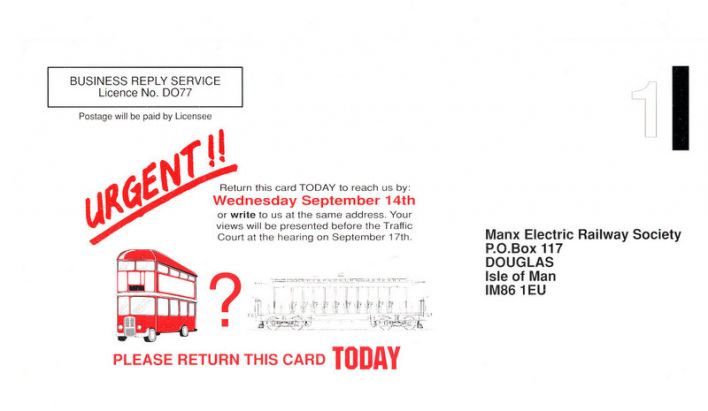
The opening years of the new century saw a new regime at the helm of the MER, and immediately a volte face in terms of maintenance and renewal took place. With hindsight there probably was no option. Wholesale replacement of the track began and serious overhaul and rebuilding of tramcars resumed. Even the winter service was brought back. All and more of these ideas had been detailed in the pages of the Society journal over many years, to which it turned out the new incumbent had been a regular subscriber. During this period the MERS supported the Railway through the production and distribution of timetable cards and even instigated and promoted a joint MER winter service initiative in conjunction with a local brewery.
However, as changes started to multiply, the real possibility of a corrosive and damaging change to the character of the line by modifications to Cars, stations and environment became apparent. To address this concern, the Society began work with the then Minister to create what was to become the Department's own 'Conservation Policy', eventually signed off by the Minister in the Autumn of 2002. This addressed the wanton defacement of tramcars and stations by needless and tasteless modernisation. More importantly it also addressed what was becoming an alarming trend at that time, the gratuitous scrapping of rolling stock. More significantly it drew a line in the sand with regard to redundant Cars which had been ousted from the threatened Laxey Depot to an uncertain future in the old bus garage at Homefield. From now on, Ministerial approval had to be sought before any rolling stock was disposed of and only after every other avenue of saving historic items had been exhausted. The policy was announced by a joint MERS/IoMT press release, but it soon became clear that whatever the wishes of the then Minister and the official policy of the Department, the transport executive would ignore its provisions at his whim...
The political machine of the Society sprang into action once again in February 2008 following the sudden announcement that the Laxey Ramsey line was to close for repairs, having been declared 'unfit' by newly appointed inspectors - this despite hundreds of thousand of pounds of expenditure. Public opinion and political pressure made sure the line was quickly reopened. History was repeated as the new Minister in charge at the time, having been on the receiving end of the attentions of the Society via the media, was replaced and later lost his seat at the 2011 election.
In addition to the political shenanigans outlined above, the 50 years of the MERS has included innumerable offers of practical, technical and other hands on help. Some of this has been warmly embraced, such as repainting of rolling stock notably Car 26, offer of appropriate upholstery, advertising, tours and shows. Other offers have been less successful, notably those of replacement trucks, ex-Blackpool reversible seats and heaters (all of which were actually purchased by the MERS and have now gone or lie neglected and unused). The appalling response to the Society's assistance with regard to unique opportunities afforded by Lisbon - and the expensive and embarrassing farce that ensued is beyond belief. Over the years, innumerable technical suggestions relating to single line and loop operation of the northern line, signalling, overhead, sleepers and fastenings, motors and controllers, depot designs, have had varying responses from successive managements, many failing to be adopted on the basis that “it wouldn't work over here." One of the most futile has been the ongoing saga of the 'carbon slipper trolleyhead' - the advantages of which have been proven the world over, and which even after three solid weeks of successful trials on top of Car 9, only to be repeatedly rejected in favour of the status quo.
Publications such as 100 editions of the Society's magazine, regarded even by its critics as a journal of record, have featured over the years dozens of definitive original articles on 'road, rail, sea and air'. Additional separate publications have run from the diminutive 1926 Rule Book reprint, to the MER 'biography' “Manx Electric", and technical reports such as the submission to the DoTs Integrated Transport Working Party. “Monthly Meetings" [sic] continue to be held in Douglas,
In February 2015, the Society officially launched its new website, designed to complement the magazine with historical and political content aimed at promoting interest and retention of the MER, and featuring public and members only pages and online membership to extend further the reach of the Society to a worldwide audience. The website is usually updated with new content on a daily basis.
Which brings us to the present. The Island's tourist industry 'never really recovered' from the fire of 1973. 'Finance' took over as the Island's principal source of income, along with what turned out to be the over generous VAT agreement with the UK. Today ongoing and unknown consequences of the financial crisis of 2008, the loss of most of the Island's VAT revenue, a worldwide clampdown on 'tax havens', we may well see a return to a time when Manx tourism is once again in the ascendant.
Summerland has gone, though the sale of its vacant site to developers may yet threaten the survival of the nearby tramway and its depot. Many other tourist amenities on this Island have also vanished or changed beyond recognition. Yet in the years since the Manx Electric Railway Society was formed, is it a coincidence that only the trams survive - almost unscathed?
